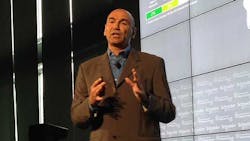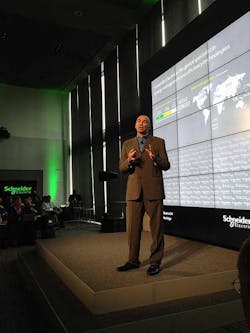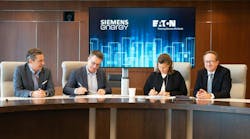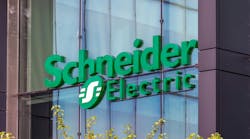Schneider Electric Event Highlights Focus on Software and Sustainability
Schneider Electric executives used their Influencer Summit 2014 event on Sept. 11 to showcase their new North American headquarters in Andover, Mass. and to give approximately 80 industry analysts and trade press editors insight into how they are positioning the company for future growth with a blend of facility, industrial and utility software and legacy brands such as Square D, Modicon and APC.
The event’s presentations all touched on a central theme — what Schneider Electric sees as a massive global business opportunity to modernize, retrofit and where necessary interconnect the existing buildings in virtually all market segments, as well as the greenfield opportunities to install the latest in interconnected energy-efficient electrical systems in new buildings. Schneider plans to link these devices with its stable of industrial, facility management and utility system software such as Wonderware, StruxureWare, other applications offered by Invensys, its recent $5.6 billion acquisition, and software for the utility market developed by Telvent, a provider of IT software and solutions for management of mission-critical infrastructure in the utility, oil & gas, water and transportation markets Schneider acquired in 2011.
The move of the company’s North American headquarters from Palatine, Ill., to a LEED-certified facility in the Boston suburbs brought the company closer to several of its research labs in the Boston metropolitan area, the region’s tech hub, and to the many engineering graduates from top-tier engineering schools like the Massachusetts Institute of Technology (MIT) and Harvard, said Laurent Vernerey, Schneider’s president and CEO, North American Operations. He is a 28-year company veteran who recently took over Schneider Electric’s top executive post in North America from Chris Curtis in Oct. 2013.
The move comes at a time that in many ways symbolized Schneider Electric’s evolution, too. Vernerey and the other executives who presented at the event all said Schneider is proud of its legacy products and that many of their customers know the company’s brands better than they know the corporate parent.
“We are known by our brands,” Vernerey said. “We want them to know the Schneider brand, too.” It will be interesting to see how he, Chris Hummel, the company’s new chief marketing officer, and the rest of the executive team position the Schneider brand with respect to the legacy brands and their desire to build up the Schneider Electric corporate brand.
Vernerey and his executive team said the company’s future depends on its ability to serve the growing need for real-time information on virtually any electrical system imaginable in regards to power usage, potential energy savings, maintenance issues, and, increasingly, potential digital security concerns. The company wants to give virtually any current-carrying electrical device an IP (Internet Protocol ) address and pull all of the power-related information from that device into software that generates customized dashboards for building managers, contractors or a company executive so they can monitor their electrical systems remotely and in real-time. He said that while Schneider Electric sees an electrical world where all devices are connected, the “real game” is, “What do you do with all of that information?” To offer some perspective on that question, Schneider Electric had Todd Isherwood, the energy efficiency and alternative energy project manager for the City of Boston, to describe how he uses some of the company’s software to manage the energy use in the city’s 321 municipal buildings.
Schneider Electric’s major areas of emphasis going forward will be: water and waste water; utility; healthcare; oil and gas; food and beverage; data centers; mining, minerals and metals, and OEMs (machine builders). Some of the specific opportunities for energy savings and sales in each of these markets are striking. For instance, in data centers, electricity can be 20% percent of operating costs, according to Schneider’s John Hoekstra, director of energy and sustainability services.
The company also sees huge growth in the utility market, in part because of the growth of the smart grid. One Schneider Electric executive said an estimated 30% of electric utilities are now running some sort of smart grid. The company is devoting significant resources to this market segment, ranging from its multi-billion dollar Telvent acquisition to its staff of 18 meteorologists who help electric utilities monitor storms that could cause power outages.
At over $30 billion in annual sales and $6 billion in U.S. sales, Schneider Electric is by no means a small player in the energy market. Globally, only Siemens (approximately $102.5 billion in total, less in electrical) and ABB (approximately $41.5 billion in total) do more. But as it positions itself to compete not only in the distribution and control markets, where U.S. electrical distributors have known brands like Square D, Modicon, APC and Telemecanique for decades, but in the utility market and in industrial and facility software, it is taking on all sorts of new competitors, including companies from the software industry. Vernerey said the company now has the overall critical mass to do what it needs to do and doesn’t anticipate making any real big acquisitions in the immediate future.
— Jim Lucy, Andover, Mass.



